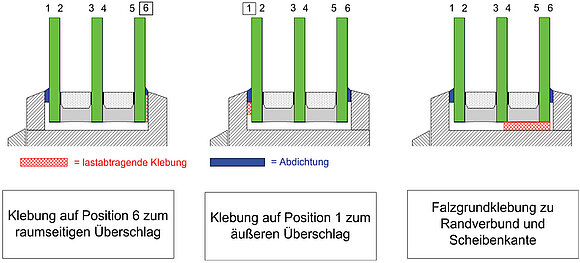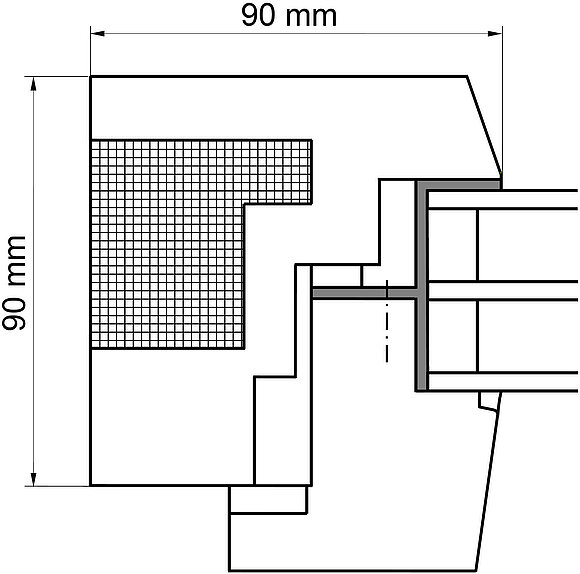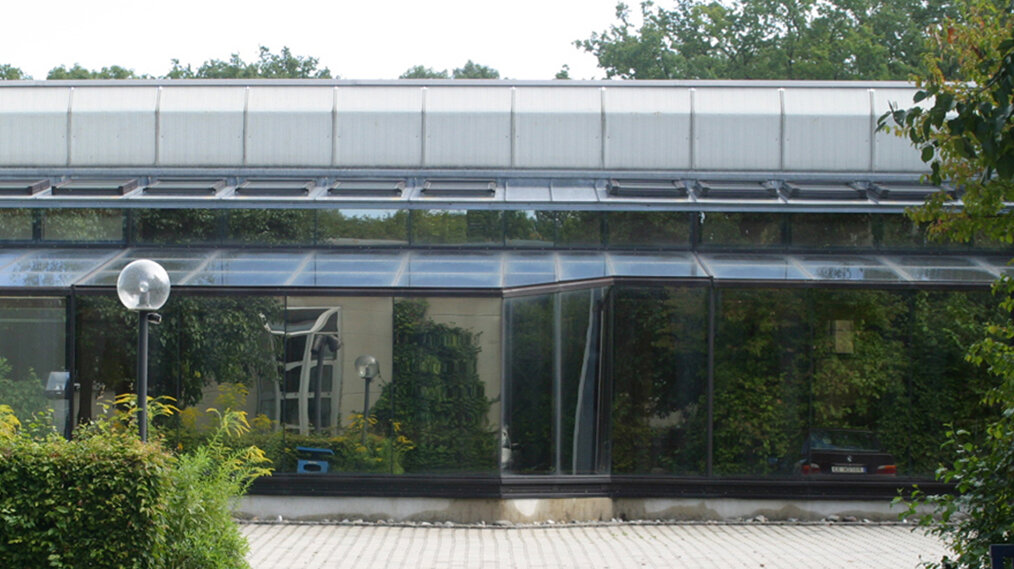Reading time: 1 minute
For decades, wooden muntin windows with small panes and low sash widths determine the look of building facades. Glazing systems with glass, frame and exposed cemented joint were the standard.
Developments up to the 80s
The architecture in the 60s with larger casements leaded to damages at the previous glazing systems that were not known until then. Overloaded cemented joints, demolitions at wood or glass enable water penetration in the wood construction. Fungal attack with destruction of the wood was the consequence.
Constructive changes led to glazings with external glazing rebate stop, internal glazing bead and sealing with plastic sealants. In 1967, the “Table for Assessment of Category of Duty for Glazing of Windows; Wooden Window” established the basis for the selection of the glazing systems. The table was revised in consideration of other frame material and found its way in the DIN standards in the 80s.
The effort for energy economy forced the use of insulating glass unit (IGU). However, the damages due to condensation in the cavity accumulated in the 70s. For all frame materials, the most common glazing type was the rebate completely filled with plastic sealant. The use of elastic sealants for weatherproofing improved the performance with external climatic effects significantly but did not solve the problems generally.

Heaped damages at the IGU after a relatively short life concerned house owners, architects and manufacturer of IGU. A reason for the condensation in the cavity was not clearly visible. Therefore, the Ministry for Regional Planning, Building and Urban Development commissioned ift Rosenheim with the ageing behaviour of IGU as well as the influence of the glazing type to ageing. The results of the research project flow into various specifications:
- Small-sized panes with large cavities have to be avoided.
- Two-stage insulating glass units (with inner butyl sealing and outer sealing with elastic sealant) achieve an higher expected utilization time.
- The glazing method can be made with sprayable sealants as well as with prefabricated profiles, both with sealant-free rebate.
- Moisture at the edge seal has to be avoided as far as possible by a tight glazing method as well as by opening of the not filled rebate area to the outside.
- A quality assurance is recommended.
A working life of 20 – 30 years for insulating glass units with bonded edge seal is expected with compliance of the mentioned specifications [6].
Joining the single panes to IGUs was technologically not solved uniformly. Brand names like “Thermopane” (edge seal soldered), “Gado” (edge seal welded) or “Cudo” (edge seal bonded) were established. The two-staged edge seal joined with organic adhesives and with spacer frames and desiccant filling still have the largest share with IGU.
The Present
The requirements for the installation of IGU in the frame have not changed substantially. The principles mentioned below are still generally valid:
- Storage:
Blocking depending on the type of opening with setting blocks and spacer pads; support of blocks on all panes and load transfer on rebate base - Removal of forces cross to plane:
Sufficient fastened glazing bead or pressure plate - Tightness of glazing rebate:
Sealing between frame and glass with sealant (with or without glazing tape) or sealing profile; dense joints of glazing bead with frame and among each other - Ventilation and moisture drainage:
Connected cavities, openings to outdoor climate
The glass has a significant effect on the performance characteristics of the window. Thus, it resulted in many solutions for special requirements that are still relevant today.

For a long time, the reduction of the transmission heat transfers was implemented only with glasses. The first triple glazings with air filling were replaced by heat protection glasses with lowE coating and gas fillings. The g-value and the light transmission were recognized as essential factors for energy efficiency and, therefore, the coatings optimized accordingly. The thermal bridge effect of the spacer frame was initially compensated by a deeper edge cover in the frame profile. In the meantime, this was made by thermally optimized warm edge systems. However, triple superstructures are relevant again for windows suitable for passive houses, only with two lowE coatings and gas filling.
A development of the glazing at windows has resulted with bonding of glass and frame [9]. For a long time implemented as structural glazing/SG-glazing in the facade area (image 2), an adaptation of the structural sealant to the window is made.

(without stepped glass bonding) [7]
The stiffening effect of the glass is better used than with mere blocking. Furthermore, the load introduction of the influencing forces of the window frame into the glass happens with substantially lower voltage peaks Current bonding techniques are (image 3):
- Overlap bonding on different positions
- Rebate bonding
- Stepped glass bonding
An important factor for the durability of an IGU is the chemical compatibility of the used material to bonding, sealing, edge seal and coatings.
Current Developments
Developments like block and/or integral windows (image 4) lead to enlarging glass surfaces. The frame is hidden behind insulation or trim, so that only the glass surface was visible. An easy fixing to the window system can be made by adapter frames (meaningfully already part of the IGU).

(strongly simplified schematic representation without relevant detailed solutions) [8]
Further properties of the integrity are increasingly transferred in the glass area, especially security issues like safety against falls, burglar resistance and fire resistance. Also the shading device is integrated in the overall construction. Closed cavity facade elements with integrated functional elements in a lightly aired cavity gain in significance. In addition, IGU with large cavities but without gas filling that are long-lastingly in touch with the ambient pressure via capillary tubes or other devices, complement the tendency to multilayer structure [10].
Another big future subject is the renovation. Especially for wooden windows, the window industry is waiting for the introduction of vacuum glass as guarded construction product, whereas the former single glazing can be replaced in proper stile with small formats and low thickness and weights. Initial approaches are visibly; however, the products are from abroad and can only be used in Germany with an approval of individual cases.
Conclusion
The specification for the important transparent part of windows and facades remain multilayered. However, there will be no “one for all” product for insulating glass units as in other areas. Triple glazing as well as other multilayered systems with partially high weights, large installation depths and further functions will retain its value in the facade area. Besides, solutions for casement windows specially for renovation are necessary that enable slim constructions according to the historic examples.
Literature
- 25 Years Institut für Fenstertechnik e.V.; An overview.
Institut für Fenstertechnik e.V., Rosenheim 1991 - Table for assessment of category of duty for glazing of windows
Institut für Fenstertechnik e.V., Rosenheim 1967 - Seifert, E.; Schmid, J:
Timber window; manual for construction and production of timber windows
Editor: Arbeitskreis Holzfenster e.V., Gießen 1969 - The Use of Customary Linseed Oil Puttys for the Glazing of Wooden Windows.
Research report of Institut für Fenstertechnik e.V., Rosenheim 1973 - Table “Category of duty for glazing of windows”.
ift Rosenheim, April 1983 - Feldmeier, F.; Heinrich, R.; Hepp, B.; Schmid, J.; Stiell, W.:
Ageing behaviour of insulating glass unit.
Research report of Institut für Fenstertechnik e.V., Rosenheim 1984 - Leuschner, I.; Hübner, C.; Lieb, K.:
„DAGI“ – Durability of bonded insulating glass units.
Research report of ift Rosenheim, 2010 - Bliemetsrieder, B.; Sack, N.:
Timber window 2012; Lasting and effective optimisation of timber profiles to reach the specifications of the Energy Saving Regulations 2012.
Research report of ift Rosenheim, 2011 - ift-Guideline VE-08/3
Basis for the evaluation of bonded glazing systems
ift Rosenheim, August 2014 - Rose, A.; Sack, N.:
Studies for Implementability of Pressure-equalised Insulating Glass Units.
Research report of ift Rosenheim, 2015




